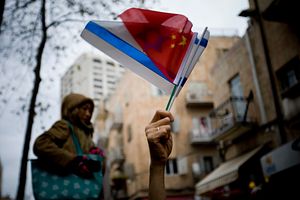The Diplomat author Mercy Kuo regularly engages subject-matter experts, policy practitioners, and strategic thinkers across the globe for their diverse insights into Asia policy. This conversation with Sam Chester ̶ venture investor at Indigo Global, an investment advisory firm specializing in emerging markets – discusses China’s growing presence in the Middle East.
Explain the motivation behind China’s growing economic and investment interest in the Middle East and Persian Gulf.
Petrochemicals, consumer markets, and advanced technology are the three resources Chinese companies and diplomats pursue in the region. Each resource plays a role in a broader policy set down in Beijing. Oil and gas imports from the Persian Gulf is essential to China’s continued economic growth, and hence this is the sole regional resource that qualifies as a national security concern. Fortunately for Beijing, access to the region’s oil and gas is secured by global energy markets that favor consumers and by the might of the United States military (along with reluctance or inability of Western energy companies to compete in Iraq and especially Iran). This allows Chinese parties to focus on expanding export markets and investing in advanced technology. The former resource mainly applies to large population states like Iran, Saudi Arabia, and Egypt, and is part of China’s decades-old Going Global policy of strengthening Chinese companies’ global profile. The latter resource applies to Israel, and since military technologies were banned in 2005, Chinese companies have targeted Israel’s commercial technologies in line with China’s national mandate to become a global leader in industrial technologies by 2025.
The Belt and Road Initiative (BRI) subsumes China’s pursuit of these three regional resources into an ambitious trans-Asian strategy, adding infrastructure projects and institutional frameworks. In the Middle East however, these new BRI frameworks will only advance China’s pursuit of the above three resources.
China has raised its naval presence in the strait of Hormuz, Bab al-Mandeb strait, and Suez Canal as well as made ports of call across the Gulf and in Egypt, Israel and Iran. Explain the importance of port presence in China’s Middle East engagement.
Petrochemicals and consumer trade are secured by naval transport. Given the Middle East’s natural naval chokepoints (Hormuz, Suez, Mandeb), each of which face high levels of geopolitical uncertainty, China’s contemporary dependence on others to secure these chokepoints and sea lanes is unsustainable in the long run. The production of films like 2018’s Operation Red Sea, a dramatization of China’s naval rescue in Yemen in 2015 that was presented to Chinese audiences as a celebration of the PLA’s 90th anniversary, underscores the role that the Chinese navy ̶ and friendly regional ports ̶ have in China’s mid-term regional strategy.
China is Iran’s top trading partner, with trade exceeding $37 billion in 2017. Explain implications for Israel.
To the extent China can be said to have a political strategy in the Middle East (given the overwhelming economic focus), it is Beijing’s success at forging close ties with regional adversaries, including Iran, Saudi Arabia, and Israel. Israel’s approach to Sino-Iranian ties is defined by realpolitik. To wit, Israeli leaders have been quick to take advantage of the leverage Beijing has in Tehran, so much so that in recent years China’s support for restricting Iran’s nuclear program has been credited in part to intervention by Israel ̶ including threats by Israeli leaders that if left with no other option, they will unilaterally attack Iran, a risk that would destabilize Chinese objectives in the region. Ultimately, Israel seeks sufficient leverage with China ̶ through technology trade or other means ̶ to obtain Beijing’s support against Iranian affiliates like Hezbollah, Assad, and Hamas.
Alternatively, as Israel and Iran both become members of Chinese regional institutions like the AIIB [Asian Infrastructure Investment Bank] and eventually, the SCO [Shanghai Cooperation Organization], I expect the two adversaries will find opportunities to oppose and even cooperate with each other and Beijing in the context of these institutions.
Assess China’s growing investment interest in Israel’s hi-tech industries.
China’s interest in Israel’s advanced technology is not new. In the 1990s, China focused on Israel’s advanced military technology. After the 2005 Harpy crisis resulted in Israel suspending military trade with China, commercial technology became the new target ̶ especially as China proceeded to make advanced technology a core element in its economic development. Even the growing U.S. trade tension with China over technology ̶ leading some observers to speculate that Israel may be forced to choose between the two superpowers ̶ is not new. It is the same choice Israel was forced to make in 2000 and 2005 when the U.S. intervened in Israel’s military trade with China.
The only difference in 2018 is that the non-military technology trade between Israel and China is not subject to U.S. limitation. This is both a matter of regulatory principle (trade in commercial AI is not a national security issue, compared to trade in missile systems) and multinational commercial reality, as nearly all the Israeli technology companies invested in by Chinese sources also have U.S. investors or U.S. market presence ̶ and address industries like agriculture, health, and alternative energy that are global issues of concern.
Why should U.S. policymakers be concerned about China’s ambitions in the Middle East?
The China model advanced by Beijing encourages regional stability, economic growth, anti-extremism, and entrenched political authoritarianism ̶ and increasingly, in a bipolar U.S.-China system, a BRI that brings the region into China’s future orbit. The U.S. in theory if not always in practice opposes political authoritarianism, and while U.S. policymakers have called for Beijing to embrace more political responsibility in the Middle East for decades, a BRI that sidelines the U.S. is not what Washington had in mind. Fortunately, given the two superpowers both fundamentally share many objectives in the region, there is more ground for cooperation than conflict, and ultimately the Middle East can be the rare geopolitical concern that allows ̶ if not forces ̶ the two superpowers to find mutually beneficial conclusions.































